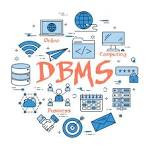

Introduction to DBMS DBMS (Database Management System): Software to store, manage, and retrieve data efficiently. Provides data abstraction, security, and concurrency control. File System vs DBMS File System: Data stored in separate files. Redundancy and inconsistency common. No proper security or concurrent access. DBMS: Centralized management of data. Reduced redundancy, better consistency. Supports queries, security, and recovery. Advantages of DBMS Data consistency and integrity. Reduced redundancy. Improved security. Concurrency control (multi-user support). Backup and recovery. Data independence. Query processing with SQL. Database Architecture 1-Tier: User interacts directly with DB. 2-Tier: Client ↔ DB server. 3-Tier: Client ↔ Application Server ↔ DB Server (most common). Data Models Hierarchical Model – Data in tree structure. Network Model – Data in graph (pointers). Relational Model – Data in tables (most widely used). Entity-Relationship (E-R) Model – Conceptual representation. Object-Oriented Model – Combines objects with DB. Schema and Instances Schema: Logical design of database (blueprint). Instance: Snapshot of data at a particular time. Data Independence Logical Independence: Changes in schema don’t affect application. Physical Independence: Changes in storage don’t affect logical schema. Database Languages DDL (Data Definition Language): CREATE, DROP, ALTER. DML (Data Manipulation Language): SELECT, INSERT, UPDATE, DELETE. DCL (Data Control Language): GRANT, REVOKE. TCL (Transaction Control Language): COMMIT, ROLLBACK, SAVEPOINT. Database Users and Administrators End Users: Interact with applications. Application Programmers: Write DB-based programs. Database Administrator (DBA): Controls access. Manages storage, backup, recovery, performance tuning. Data Dictionary Metadata repository (data about data). Stores info about tables, schemas, constraints, users. Entity-Relationship Model Entities: Real-world objects (e.g., Student, Course). Attributes: Properties of entities (e.g., Name, Age). Relationships: Associations between entities (e.g., Enrolls). Keys: Primary Key – Uniquely identifies entity. Foreign Key – Refers to another entity’s key. E-R Diagram Components Entity: Rectangle. Attribute: Oval. Relationship: Diamond. Primary Key: Underlined attribute. Cardinality: 1:1, 1:N, M:N notation.
Course Description: Database Management Systems (DBMS)
This course introduces the fundamental concepts of Database Management Systems (DBMS), focusing on the principles, architecture, and design of databases. It provides an understanding of how data is stored, managed, and retrieved efficiently in modern applications. The course covers both theoretical aspects and practical applications of database systems.
Course Coverage
1. Introduction to DBMS
Concept of DBMS as software for efficient data storage, management, and retrieval.
Features: data abstraction, security, concurrency control.
2. File System vs DBMS
Limitations of traditional file-based systems.
Advantages of DBMS: centralized control, reduced redundancy, query support, security, recovery.
3. Advantages of DBMS
Data consistency and integrity.
Multi-user support with concurrency control.
Backup and recovery mechanisms.
Query optimization and SQL support.
4. Database Architecture
1-Tier, 2-Tier, and 3-Tier architectures.
Role of application servers and client–server models.
5. Data Models
Hierarchical, Network, Relational, E-R, and Object-Oriented models.
Focus on relational and E-R models as widely used frameworks.
6. Schema and Instances
Distinction between schema (logical design/blueprint) and instances (current snapshot of data).
7. Data Independence
Logical independence: isolation of schema from applications.
Physical independence: isolation of storage from logical schema.
8. Database Languages
DDL: CREATE, DROP, ALTER.
DML: SELECT, INSERT, UPDATE, DELETE.
DCL: GRANT, REVOKE.
TCL: COMMIT, ROLLBACK, SAVEPOINT.
9. Database Users and Administrators
End users, application programmers, and Database Administrators (DBAs).
Responsibilities of DBAs: access control, storage management, backup, recovery, performance tuning.
10. Data Dictionary
Metadata repository that stores details about schemas, constraints, tables, and users.
11. Entity-Relationship (E-R) Model
Entities, attributes, and relationships.
Primary keys and foreign keys.
E-R diagram components: rectangles (entities), ovals (attributes), diamonds (relationships), underlined attributes (keys), cardinality (1:1, 1:N, M:N).
🎯 Learning Outcomes
By the end of the course, students will be able to:
Understand the need for databases and compare DBMS with traditional file systems.
Demonstrate knowledge of DBMS architecture and data models.
Design schemas using E-R models and implement them in relational databases.
Apply concepts of data independence and use SQL for database operations.
Identify roles of different database users and administrators.
Manage data dictionary, constraints, and metadata effectively.

0 Reviews
my self Im Iswarya working Assistant Professor in GVN College ,department of computer Science ,thank you
